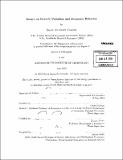| dc.contributor.advisor | David Laibson and Drazen Prelec. | en_US |
| dc.contributor.author | Cesarini, David Alexander | en_US |
| dc.contributor.other | Massachusetts Institute of Technology. Dept. of Economics. | en_US |
| dc.date.accessioned | 2010-08-31T16:24:42Z | |
| dc.date.available | 2010-08-31T16:24:42Z | |
| dc.date.copyright | 2010 | en_US |
| dc.date.issued | 2010 | en_US |
| dc.identifier.uri | http://hdl.handle.net/1721.1/57897 | |
| dc.description | Thesis (Ph. D.)--Massachusetts Institute of Technology, Dept. of Economics, 2010. | en_US |
| dc.description | Cataloged from PDF version of thesis. | en_US |
| dc.description | Includes bibliographical references. | en_US |
| dc.description.abstract | This thesis is a collection of papers in which behavior genetic methods are used to shed light on individual differences in economic preferences, behaviors and outcomes. Chapter one uses the classical twin design to provide estimates of genetic and environmental influences on experimentally elicited preferences for risk and giving. The paper reports evidence that these preferences are broadly heritable, with estimates suggesting that genetic differences explain approximately twenty percent of individual variation. The results thus point to genes as an important source of individual variation in preferences, a source which has hitherto been largely neglected in the economics literature. The chapter is written with Christopher T. Dawes, Magnus Johannesson, Paul Lichtenstein and Bjorn Wallace. Chapter two shows that these findings also extend to the field. Following a major pension reform in the late 1990s, all Swedish adults had to form a portfolio from a large menu of funds. Matching individual investment decisions to the Swedish Twin Registry, the paper finds that approximately 25% of individual variation in portfolio risk is due to genetic variation. The results, which are complementary to those reported in chapter one, also hold for several other aspects of financial decision-making. The chapter is written with Magnus Johannesson, Paul Lichtenstein, Orjan Sandewall and Bjorn Wallace. Chapter three uses two complementary Swedish datasets to examine the importance of family environment in explaining variation in income, educational attainment, and measures of cognitive and non-cognitive skills. Using seven different sibling types who differ in their degree of genetic relatedness and rearing status, I find moderate family effects on educational attainment, cognitive skills and non-cognitive skills. This contrasts with the effects of family on income, which are low. Additional analyses, based on a sample of identical (MZ) and fraternal (DZ) twins for which more comprehensive income data is available, reveal large and persistent separation of the MZ and DZ correlations over the entire lifecycle, except at very early ages. One interpretation of this finding is that there are strong family effects on the timing of labor market entry. I discuss the relevance of these results for efforts to understand the causes of income inequality. | en_US |
| dc.description.statementofresponsibility | by David Alexander Cesarini. | en_US |
| dc.format.extent | 148 p. | en_US |
| dc.language.iso | eng | en_US |
| dc.publisher | Massachusetts Institute of Technology | en_US |
| dc.rights | M.I.T. theses are protected by
copyright. They may be viewed from this source for any purpose, but
reproduction or distribution in any format is prohibited without written
permission. See provided URL for inquiries about permission. | en_US |
| dc.rights.uri | http://dspace.mit.edu/handle/1721.1/7582 | en_US |
| dc.subject | Economics. | en_US |
| dc.title | Essays on genetic variation and economic behavior | en_US |
| dc.type | Thesis | en_US |
| dc.description.degree | Ph.D. | en_US |
| dc.contributor.department | Massachusetts Institute of Technology. Department of Economics | |
| dc.identifier.oclc | 655830919 | en_US |
